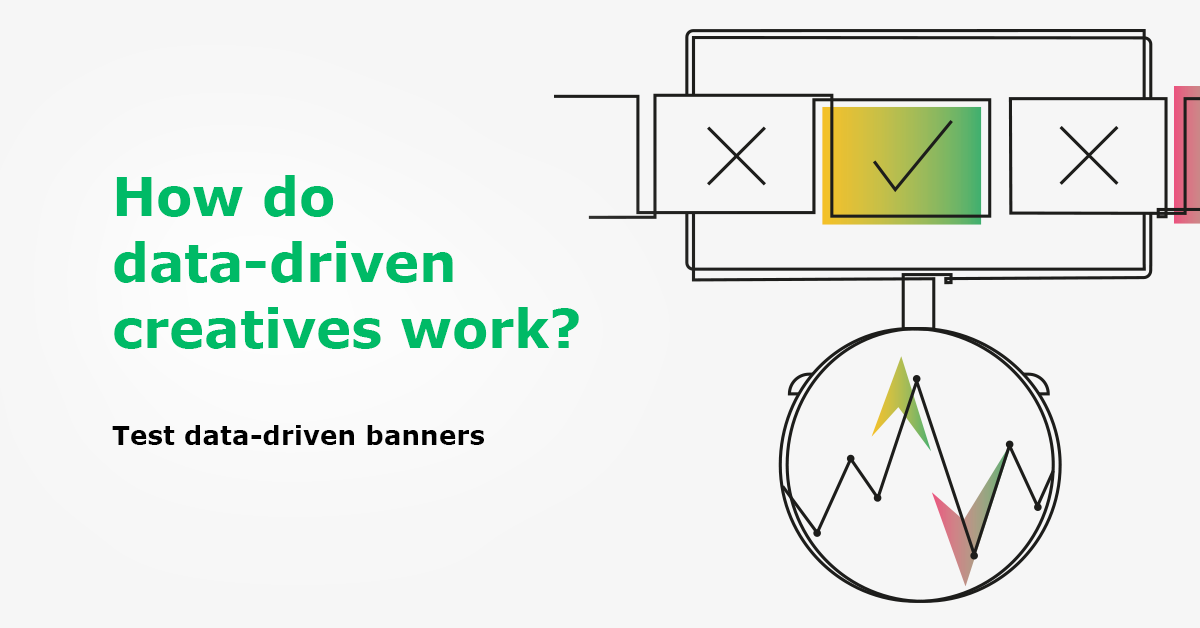Data are a must-have in today’s digital world. There is no effective marketing without it. Use them in creatives too and give people content they want to see (i.e. data-driven) How can you do that?
In online campaigns, data-driven attribution is commonly used. Audiences are created based on detailed customer data or development is predicted based on historic results. Why not use data in a creative itself?
It doesn’t have to be complicated. We will show you how to use data-driven formats offered by Display & Video 360 (DV360) from Google.
How do data-driven creatives work?
In principle, it’s simple. It is a banner that changes its content based on current information about the user. Thus, users see an advertisement that is potentially more relevant than if one general banner targeted all users.
At first sight, it works similarly to dynamic creatives created using the Creative Studio we recently wrote about. What’s the difference?
Although use-case dynamics and data-driven creatives are often identical, their setting and functioning are very different.
Data-driven vs. dynamic creative
A data-driven creative has no truly “dynamic” elements; that’s why each version must be prepared separately. That is the main difference.
- For the dynamic creative, the system fills the banner area using materials from the feed based on filters.
- For the data-driven creative, each version is fixed and the system selects one of these versions to display based on set rules.
Thus, the data-driven creative is not suitable for dynamic remarketing advertising, but will find its place in the promotion of specific products or services.
3 advantages of a data-driven creative
Data-driven formats have several advantages over dynamic (Studio) creatives:
- Simpler preparation
One of the most important issues. The Studio creative needs many steps even for basic solutions, e.g. feed preparation, filter organization or template configuration in Google Web Designer. For the data-driven creative, you can just upload the documents in the interface in most cases.
- Easy application
Creatives are created in Ad Canvas for immediate additions to campaigns. No need to deal with Publishing/Ad Serving in Campaign Manager or in Studio settings.
- Immediate adjustment
Versions are adjusted directly in the interface, similarly to classic responsive advertising.
How do you prepare a data-driven creative?
To create data-driven creatives, there are several responsive system templates which work similarly to responsive advertisements in PPC. You can find them in the DV360 interface in the Format Gallery section. These formats can now also be created in a dedicated tool from Google Ads Creative Studio.
Panorama template
Cuecard template
Blank Slate template
Individual elements and their parameters are defined in their own templates using a data scheme. This is what is called a Brand Awareness Schema. If the basic layout is not enough for you, we can code another one using Google Web Designer.
Of course, it is also possible to record versions in the external feed, which allows automatization of their creation to a certain extent.
How to control specific displays
In the next step, set the display rules. Which banner is displayed to the user is managed by the system based on signals defined by us. The rules work based on IF/THEN logic.
As signals, we can use:
- Lists of audiences (including system, in-market and owned audiences)
- Categories (system in-market audiences)
- Location
- Date and time
- Targeting structure in DV (Line Item)
By combining several different signals, we can precisely segment our target audience. In this case, we can also save work using the external feed rules.
Is it right for your business?
Data-driven creatives are useful mainly in extensive and more generally targeted campaigns, but also in specific events.
It will help to increase CTR and conversion ratio of all events where it is more efficient to reach users with a more specific message within broad targeting.
In general, data-driven creatives are recommended for advertisers who:
- offer a wide range of products/services for various target groups/locations
- expect users to respond well to more personalized messages
- have active display campaigns to such an extent so that the respective campaigns can gather enough data to evaluate the output.
Before implementing data-driven creatives, it is necessary to estimate whether and to what extent this creative is beneficial in the given situation.
If the target audience is narrow and the interest in the product is stable in time and space, the value added of the data-driven advertising will be smaller.
It makes more sense if you have a fluctuating demand, a wide range and target it to a large part of the population.
Would you like to discuss details?
The right combination of rules and settings is the key to success. We will be pleased to assess the options, test and apply the best solution. Just let us know.
If you are still hesitant, read more about the DV360 tool, which belongs to Google Marketing Platform. In a series of articles, we have described our experience with using other interconnected tools, e.g. Search Ads 360, Campaign Manager 360, Studio and Surveys 360.


